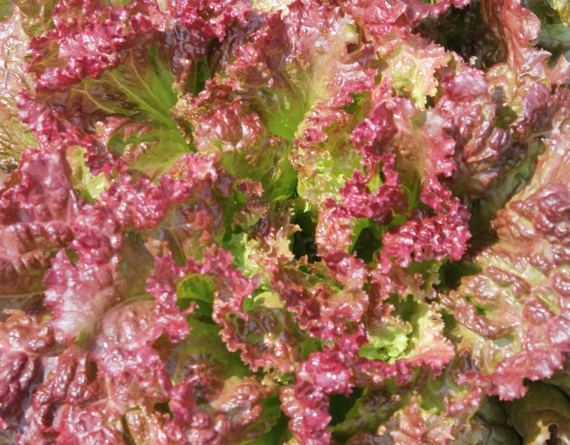- Home
- Products
- Plants
- Vegetables
- Lettuce
- Ruby Red Lettuce
At the Farm
Take a Peek
-
 Lemon Cucumber
$3.00 – $8.00
Lemon Cucumber
$3.00 – $8.00
-
 Zucchini Black Beauty
$3.00 – $8.00
Zucchini Black Beauty
$3.00 – $8.00
-
 Cherry Pepper Plant
$3.00 – $8.00
Cherry Pepper Plant
$3.00 – $8.00
-
 Anaheim Pepper Plant
$3.00 – $8.00
Anaheim Pepper Plant
$3.00 – $8.00
-
 Poblano Pepper Plant
$3.00 – $8.00
Poblano Pepper Plant
$3.00 – $8.00
Ruby Red Lettuce
$3.00 – $5.00
Ruby red lettuce, also known as red leaf lettuce or red oak leaf lettuce, has a mild and slightly sweet flavor compared to other lettuce varieties. Its taste is often described as being similar to green leaf lettuce but with a slightly nuttier and peppery undertone. The leaves are tender and have a delicate texture, making them ideal for salads, sandwiches, or garnishes. Additionally, the vibrant red color adds visual appeal to dishes. Overall, ruby red lettuce offers a refreshing and mildly flavorful addition to salads and other culinary creations.
Description
Ruby red lettuce, also known as red leaf lettuce or red oak leaf lettuce, has a mild and slightly sweet flavor compared to other lettuce varieties. Its taste is often described as being similar to green leaf lettuce but with a slightly nuttier and peppery undertone. The leaves are tender and have a delicate texture, making them ideal for salads, sandwiches, or garnishes. Additionally, the vibrant red color adds visual appeal to dishes. Overall, ruby red lettuce offers a refreshing and mildly flavorful addition to salads and other culinary creations.
Caring for a ruby red lettuce plant involves providing it with the right growing conditions, proper watering, and occasional maintenance. Here are some care tips for growing ruby red lettuce:
- Location: Plant your ruby red lettuce in a location that receives partial sun to full sun. However, in hot climates, providing some shade during the hottest part of the day can prevent the leaves from wilting or becoming bitter.
- Soil: Use well-draining, fertile soil with plenty of organic matter. Ensure the soil pH is around 6.0 to 7.0 for optimal growth.
- Planting: Sow ruby red lettuce seeds directly into the garden bed or container, spacing them according to the variety’s recommendations (usually about 6-12 inches apart). Alternatively, you can start seeds indoors and transplant seedlings outdoors once they have developed a few true leaves.
- Watering: Keep the soil consistently moist but not waterlogged. Water deeply whenever the top inch of soil feels dry to the touch. Avoid overhead watering, as this can increase the risk of disease.
- Fertilizing: Apply a balanced fertilizer or compost to the soil before planting and again as the plants grow. Alternatively, you can use a water-soluble fertilizer every few weeks during the growing season.
- Mulching: Apply a layer of organic mulch, such as straw or shredded leaves, around the base of the plants to conserve moisture, suppress weeds, and regulate soil temperature.
- Thinning: Thin out overcrowded seedlings to allow adequate airflow and prevent competition for nutrients. This will help promote healthier growth and reduce the risk of disease.
- Pest and Disease Control: Monitor the plants regularly for signs of pests or disease, such as aphids, slugs, or fungal infections. Use organic pest control methods, such as handpicking pests or applying neem oil, if necessary.
- Harvesting: Harvest ruby red lettuce leaves when they reach the desired size, typically about 4-6 inches long. You can harvest individual leaves as needed or cut the entire plant about 1 inch above the soil surface for a full harvest.
By following these care tips, you can ensure your ruby red lettuce plants thrive and provide you with a bountiful harvest of vibrant, tasty leaves.
Additional information
| Size | 6 seedlings, 4 in pot |
|---|
Only logged in customers who have purchased this product may leave a review.
RelatedProducts
Black Krim Tomato Plant
$3.00 – $8.00The Black Krim tomato is a distinctive heirloom variety prized for its rich, complex flavor and striking appearance. These large, beefsteak-type tomatoes feature deep purplish-black skin with green shoulders when ripe. Known for their exceptional taste, Black Krim tomatoes have a sweet, smoky flavor with hints of saltiness, making them perfect for slicing and adding to sandwiches, salads, or enjoyed fresh.
Dr Whyche’s Yellow Tomato
$3.00 – $8.00Red Russian Kale
$3.00 – $8.00Black Krim Tomato Plant
$3.00 – $8.00The Black Krim tomato is a distinctive heirloom variety prized for its rich, complex flavor and striking appearance. These large, beefsteak-type tomatoes feature deep purplish-black skin with green shoulders when ripe. Known for their exceptional taste, Black Krim tomatoes have a sweet, smoky flavor with hints of saltiness, making them perfect for slicing and adding to sandwiches, salads, or enjoyed fresh.
Dr Whyche’s Yellow Tomato
$3.00 – $8.00Red Russian Kale
$3.00 – $8.00Black Krim Tomato Plant
$3.00 – $8.00The Black Krim tomato is a distinctive heirloom variety prized for its rich, complex flavor and striking appearance. These large, beefsteak-type tomatoes feature deep purplish-black skin with green shoulders when ripe. Known for their exceptional taste, Black Krim tomatoes have a sweet, smoky flavor with hints of saltiness, making them perfect for slicing and adding to sandwiches, salads, or enjoyed fresh.









Reviews
There are no reviews yet.